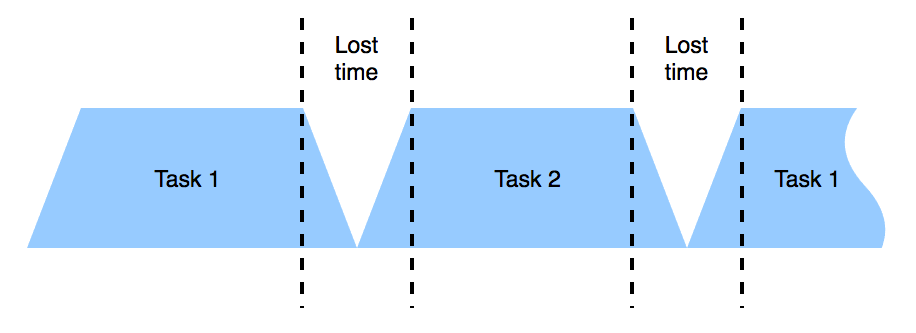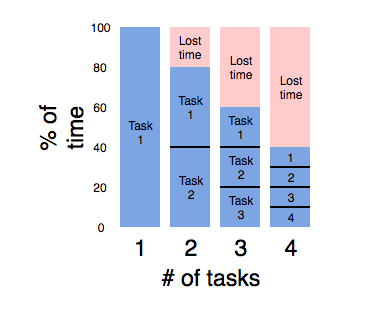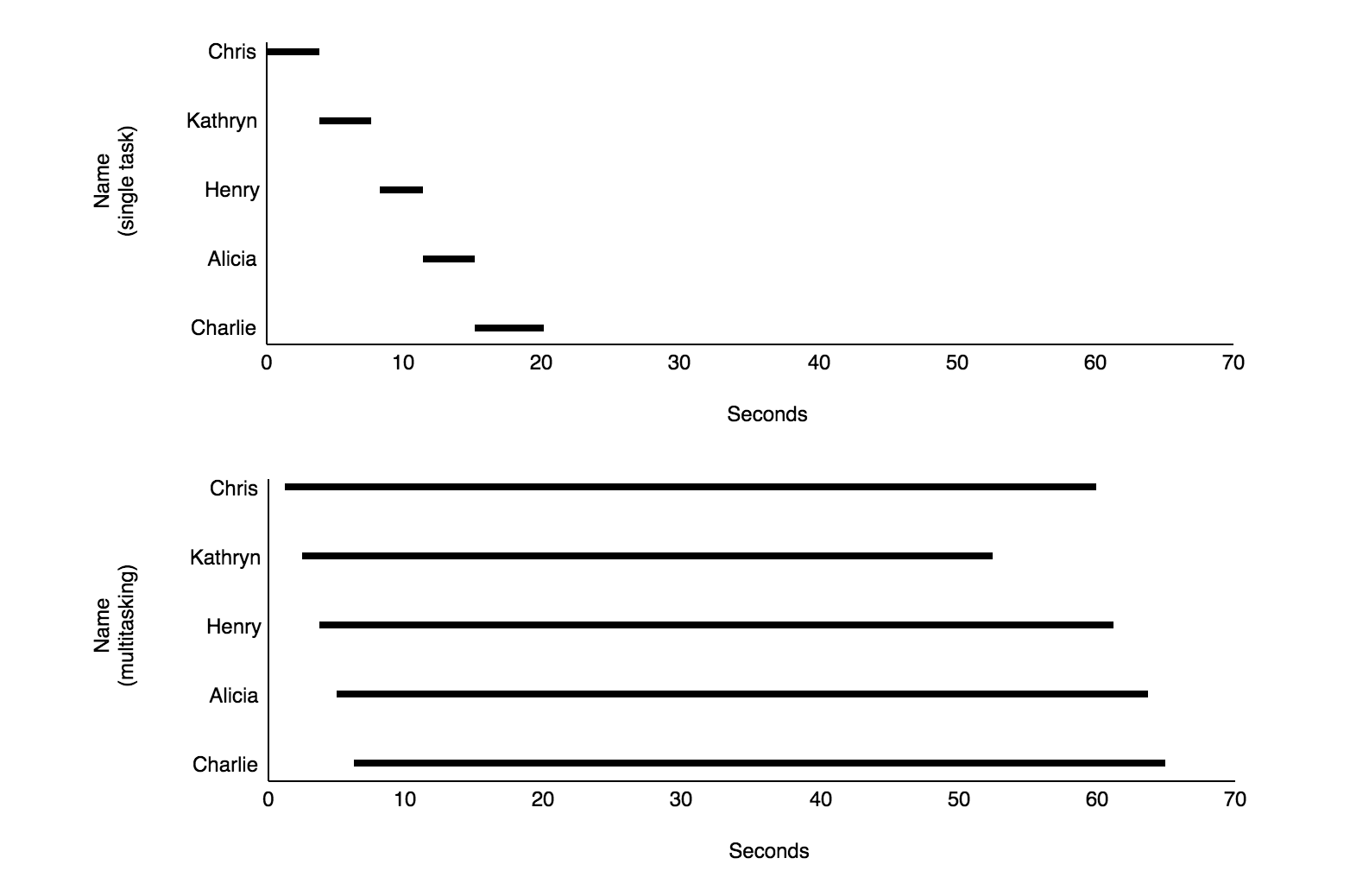tl;dr: By defining a sales workflow that removes multitasking by setting roles and outsourcing tasks through automation, you can see sales productivity skyrocket along with your revenue.

If a sales rep is busy researching leads, scheduling meetings, and email prospects, you might see one awesome salesperson.
On the other hand, this could be a disaster. Lost sales productivity costs companies $1 trillion per year. This isn’t because of bad salespeople. It is built into the way we work. It is because we see reps multitasking, taking on every job in the sales process, as a positive sign, when it’s actually a killer for your organization.
Any time your team has to switch tasks, they don’t close deals. Here’s why.
The perils of context switching
Multitasking seems like it should increase productivity. After all, you’re working on more than one thing at a time. If you are stuck on one task, you can just hop over to the other and take that up. No downtime, more efficiency.
Except that’s not what happens. When you take on two tasks instead of one, the assumption is that you will now split your time 50/50. But switching tasks isn’t an immediate ramp-down/ramp-up scenario. Instead, it’s more like this:

You stop one task and ramp down, then have to ramp up to start the next. There is an overhead incurred in the switch.
This problem quickly compounds. In his book Quality Software Management: Systems Thinking, computer scientist Gerald Weinberg says that if you are just losing 10% of your time per task switch then by the time you have four different tasks running simultaneously, you are only working in each of those tasks 10% of the time:

(Adapted from Carnegie Mellon University)
These are best-case scenarios where you ramp-down and ramp-up immediately. You also need to factor in that the transition is a good time to grab a coffee/check email/check chat.
When you have to multitask, productivity isn’t the only thing that suffers. So does quality.
How long does it take to write a name?
A great example of how context-switching leads to low-quality, low-efficiency work is the multitasking name game.
Let’s say you have to write down the name of five people you’ve never met. Each person tells you their name and you write it down. Easy. It probably takes 3-4 seconds per name, so you’ll complete the task in about 20 seconds.
Now try the same thing, but switching tasks as you go. You ask the first person their name, and they say “Chris,” so you write a “C.” Then you hop to the next person and ask their name and write the first letter. So on until you get back around to Chris and you write the “h,” then move on to the next name again.
Whereas the first scenario takes 20 seconds, Agile coach Henrik Kniberg found that the second multitasking scenario can take over a minute:

(Adapted from Crisp)
Not only does it take longer, but the quality isn’t as good either, both in terms of the written name and the experience. People playing this game often have to re-ask the person’s name as they have forgotten it by the time they get back around.
This is a factor of the way our brains work, and is as true of sales as it is writing a name down. We keep some information in our working memory to help us complete the task we are paying attention to at that time. Once we switch to another task, all that information is lost. Our working memory is then filled with information for that task. When you switch back, you have to restore that initial working memory.
This is why we need to ramp down and ramp up, and why multitasking quickly becomes more about juggling information rather than productivity.
In a sales organization, all this wasted effort adds up. Even if reps are just completing three tasks each—prospecting, scheduling, and closing—you’re losing over three hours a day to switching overhead. That’s two days a week or about 20 weeks in a year that your team is stopping one task, starting another and not closing deals.
The ideal stack of an optimal flow
The issues with context-switching should show that the optimal workflow for any sales team means having people work as much as possible on just one task at a time. That means delineating the tasks across segmented teams, asynchronizing tasks to remove stopping points, and automating as much as possible to remove tasks from the workflow.
Segment and delineate
Modern sales is a team endeavor. No single rep should be covering the entire pipeline. When they do, context-switching is inevitable as they go from researching prospects to developing sales collateral to closing deals in the space of a single afternoon. Not only are fewer deals being made, but a rep with such a varied workload isn’t going to be skilled in any one job. Quality suffers.
You should consider at least three separately defined roles:
- Marketing—A person or team that is wholly focused on the top of the funnel.
- Sales Development Rep—A defined role that is focused on taking prospects through the qualification process to become an opportunity.
- Account Executive—A rep who is entirely focused on closing deals.
You’re probably already separating out marketing, and some might already have SDR/AE delineation. Some sales-heavy groups are trying to take this segmentation further and carve out a pure research role.
However you do it, the important word is focus. Having each team member focus on a single priority means two things:
- A reduction in context-switching as they don’t have to juggle multiple tasks.
- An increase in quality in their defined role, as they can concentrate on the skills needed to succeed in a single task.
Asynchronize effort
This is harder to achieve in a fast-paced sales organization. Each individual role needs to be able to work asynchronously and autonomously, even though they are part of a wider pipeline.
The answer to this problem is to develop a process to optimize for rep efficiency. Using data, you can analyze the sales process and find the rate limiting factors.
If a fourth specialization could be added to the list above, it would be sales operations roles. Though they sit outside the pipeline, the holistic, data-centric view of sales ops helps reps be more efficient and close more deals by:
- Setting goals—work with the executive team on setting the bookings goal for the quarter/year. They provide important insight on the underlying metrics on whether the goal is feasible for the team.
- Developing processes—sales ops can define each stage of the buyer process, when it makes sense to move opportunities along the funnel, and find the places where automation will increase efficiency.
- Measuring success—with access to the analytics from the team, they are vital in determining which processes and tools are working, along with how team members are spending their time.
- Iterating and improving process—all of this can provide constant feedback, allowing for processes to become more defined and refined over time.
At each stage, they are working with reps, managers, and execs to implement the right workflows and the right tools for the team. By becoming the people focused on the operational side of the sales team, they allow the VP of Sales to focus entirely on strategy and working with reps to close deals.
Automate everything
If focus is key, anything that pulls focus away from the one key task means lost productivity. But each of those main tasks is made of smaller sub-tasks. It’s turtles all the way down.
This is where the beauty of SaaS comes in. From pre-contact → prospect → lead → opportunity → customer, each stage of the sales process can be underpinned with better automation:
- Research efficiently when prospecting with Mattermark—Manual research is possibly the biggest time suck that sales teams can easily undo. Mattermark lets you find out all the information on companies and key decision makers quickly. A single search can yield all this firmographic data an SDR would need to reach out to hundreds of potential customers.
- Personalize at scale with Outreach—Another area where reps lose time is outreach. They need to walk a fine line between getting emails out quickly and personalizing enough that they are of interest to the prospect. Email tools such as Outreach allow you to quickly use the information gathered during your research phase to personalize email and send targeted campaigns along industry, account type, and business model.
- Automate lead scoring with our APIs—Using just behavioral data when lead scoring leaves you without a true understanding of your customer or their potential value to your company. You only have half the data you need to discern the patterns that predict success with a customer. The other half can come from pulling in company data programmatically through Mattermark APIs. You can set this up to discover more about each new prospect as they come in, finding out what characteristics all your customers share, and whether your prospects have the hallmarks of a future VIP.
- Make your CRM the source of truth with Close.io—All this can be tied together in a single tool, your CRM. Whether your going all out on Salesforce, or need a CRM more tailored to startup needs like Close.io, a CRM can tie together your process and information. As SDRs research companies and people, they can link that firmographic information direct to accounts within your CRM, so that AEs have it instantly when they are on calls or in meetings.
These are only the major components of a sales stack. The exciting part of modern sales SaaS is that there is a tool for everything. You get a SaaS, you get a SaaS, everybody gets a SaaS!
Each of those sub-tasks can be handed off to a separate part of the stack, freeing up time for the rep and reducing the need for switching from task to task.
- Project management: Teamwork Projects lets you assign tasks to different members of your team and track progress across the organization.
- Meetings: UberConference is an easy way to set up meetings and demos for prospective customers when they are through to the opportunity stage.
- Contract management: HelloSign takes the pain out of sending and receiving important documents and making sure everything is signed on time by all parties.
- Analytics: InsightSquared allows your sales ops to connect multiple data sources and produce reports that let you better understand your sales process and rep performance.
- Hiring: SalesDrive is entirely focused on the hiring process for sales teams, allowing you to assess, interview, and hire the right reps for your company.
- Communication: Front lets you draw all of your prospect and team communication in to one single place, making it easier for your team to collaborate as well as respond to any time-critical opportunity issues.
These are just a few examples. For any task that your team has to perform, ask whether there is already a solution in place that will unburden your reps.
Streamlining your productivity
Context-switching will kill productivity. The more you are asking your reps to do, the less they will be able to accomplish. Only by allowing them to focus on the one thing they want to do and you want them to do—sell—can you succeed. Give each member of your team one goal and then work to clear everything out of their way.
To do this, you need process and automation. By defining a sales workflow that removes multitasking by setting roles and outsourcing tasks, you can see sales productivity skyrocket along with your revenue.
Also published on Medium.
